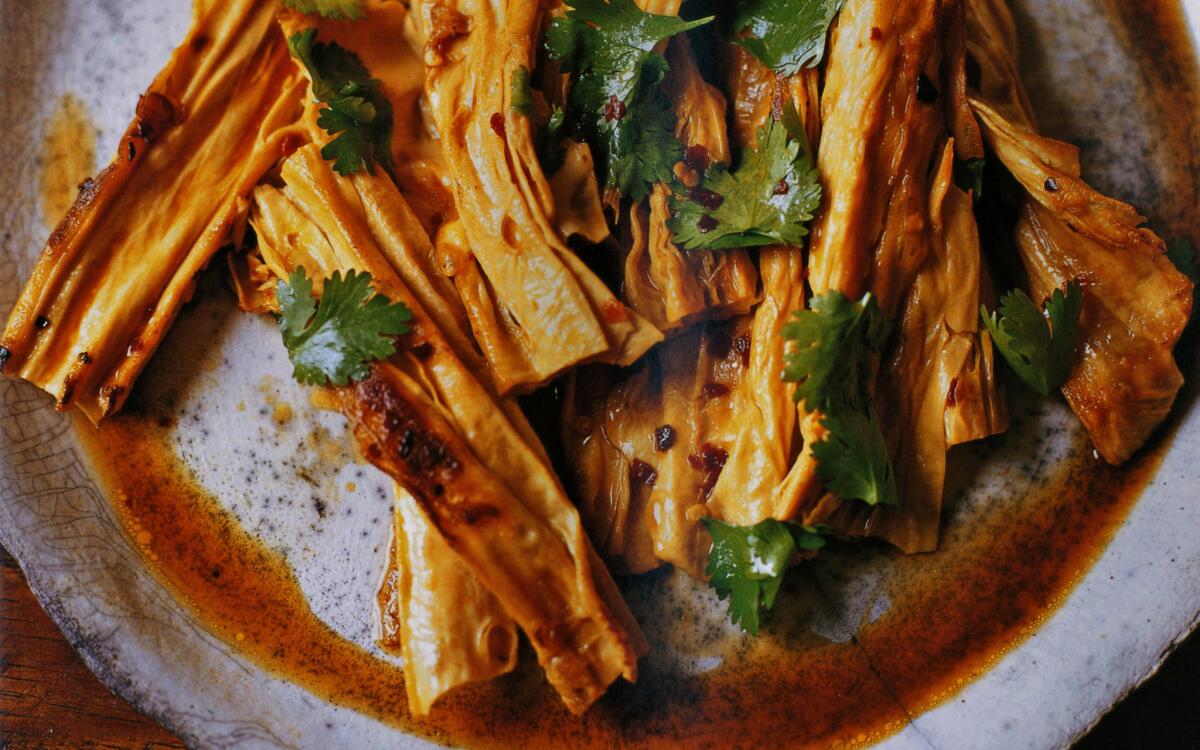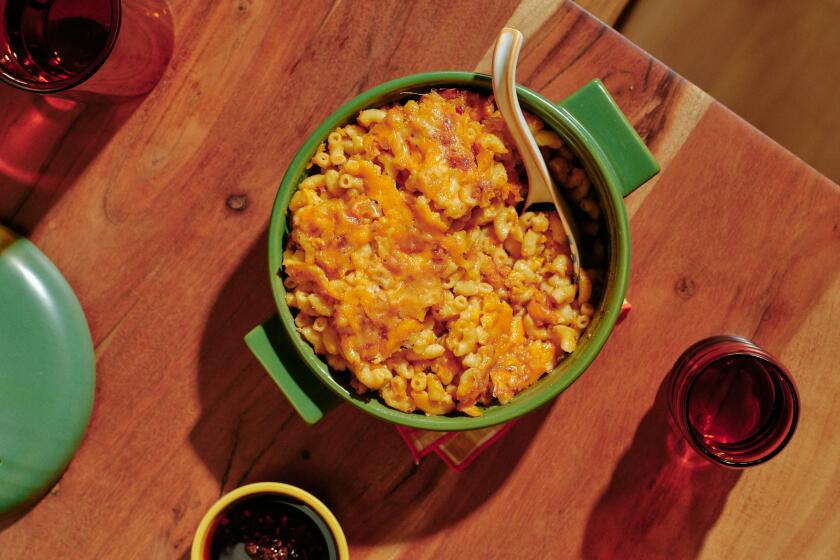Tofu batons with hot sesame dressing

Imagine the cookbook as Lonely Planet guide -- trail-stained, river-logged, loaded with maps and pictures, the recipes like scrawled postcards -- and you get an idea of the kind of books Jeffrey Alford and Naomi Duguid write.
“Beyond the Great Wall: Recipes and Travels in the Other China” is the sixth cookbook by Alford and Duguid, the Toronto-based husband and wife team who met as travelers in Tibet. In this, their first book to tackle the cuisine of a single country, Alford and Duguid are interested not in codifying Chinese food (a questionable task anyway) but in the cooking of the nation’s mountains and steppes, its silk roads and peripheries, the “other China” beyond the increasingly Westernized urban centers.
The book’s recipes -- gorgeously photographed in studio by Richard Jung -- are interspersed with terrific location shots taken by Alford and Duguid, as well as with vignettes written by the couple over the course of their trips through the region. It reads like a tattered food diary, an expat travel journal, a far-flung love story, a Graham Greene novel unbound and reassembled with recipes.
The recipes are easy to follow, and use techniques that are as familiar as most of the ingredients, even the most obscure of which can be found at farmers markets or Asian grocery stores. Pretty impressive for a book that combines the cuisines of Guizhou and Tibet, Xinjiang and Inner Mongolia, and features recipes for dishes that are built from fermented pastes, hand-pulled noodles and bone broths.
China opened its borders in the early ‘80s; Alford and Duguid traveled there extensively in the intervening years. But it was the outlying provinces that caught their attention, as much for the profound changes that were taking place as for the diverse and fascinating food they discovered there.
This food is well worth the trip -- or trips. The recipes are loaded with flavor, torqued with spice and fraught with heat, either from fiery chiles or the open flame. And they’re balanced too.
A dish of fresh soybeans, or edamame, sounds far more ordinary than it looks -- or tastes. The beans are cooked simply, boiled in a water bath that’s spiked with star anise, chiles and five cloves of garlic. The dish has a bright heat and glorious color that belies its simplicity.
Dried tofu batons get a brief soak, a quick stir-fry in a pungent blend of sesame oil, rice vinegar, soy sauce and chile flakes, and a generous sprinkling of fresh cilantro. It’s a revelation of how good tofu can be in the right hands.
The list goes on. I cooked 14 recipes and not one of them disappointed. It helps that the authors have as much of a range -- they’ve written books on Indian and Asian food; their last cookbook was on baking -- as the food they’re profiling.
The Kazakh family loaf, a recipe from the mountains of northern Xinjiang, is a basic yeasted bread but with yogurt stirred into the simple dough. Baked in a lidded pot, the bread has a dense, moist crumb and a glorious burnished crust.
Uighur nan is similarly user-friendly, the easy flatbreads rolled out, pricked with a fork and sprinkled with salt and cumin seeds before a quick bake on a hot stone. Crisped yet pliant, the breads are the perfect foil for a simple tomato salsa made with fresh tomatoes, sesame oil and minced scallions.
Alford and Duguid are great with main courses too. Lamb kebabs are doused with an easy marinade of chopped onion, garlic and pomegranate juice, then grilled on an open flame. Terrific Mongolian lamb sausages, ground lamb cooked into little patties, are jazzed by generous amounts of fresh ginger, scallions, garlic and cilantro.
And deep-fried whiting, the delicate pieces of fish neither skinned nor boned, get a spicy tempura coating with a simple paste of cornstarch and homemade chile sauce. It’s a wonderful recipe and, sans cornstarch, the sauce makes a great marinade for grilled meat too.
Among the few desserts, Tibetan rice pudding is a simple, subtle standout. It’s just milk and “broken” rice (literally, grains of jasmine rice that have been broken), dried apples and honey. But after slow cooking, the simple ingredients are transformed into a creamy dessert, subtle with fruit, adorned with rivulets of additional honey and low clouds of tangy yogurt.
More involved dishes, such as some of the spicy condiments and pickled vegetables, might require a few more steps. A recipe for pickled radish threads instructs readers to mix grated daikon with aromatics and seasonings, layer in salt, Sichuan pepper and vinegar, then “place in a sunny spot by a window for 2 to 4 days.”
This is that rare book that works on each of the levels to which it aspires: travelogue, cultural anthropology, cookbook. Most important, the food -- as storied and diverse as the people who inspired it -- works too.
Add 2 inches of water to a medium pot and bring to a boil. Add the tofu sticks, breaking them if necessary to submerge them. Remove from the heat. Weight down the sticks with a plate that fits inside the pot. Cover and let sit for 30 minutes.
Remove the plate and drain the tofu well. Cut the sticks into 2-inch lengths, trimming and discarding any tough bits. Cut the sticks lengthwise in halves or into quarters, to make narrow batons. Set aside.
Heat a wok or wide heavy pot over medium-high heat. Add the peanut and sesame oils. When the oil is hot, add the chile pepper flakes and the tofu batons and stir-fry for 2 minutes, stirring and pressing on the batons to expose them to the hot surface of the pan.
In a small bowl, combine the vinegar, soy sauce and sugar and whisk well, then pour over the tofu batons. Stir-fry briefly to distribute the flavors, and continue to cook until the liquid is mostly absorbed. Remove from the heat.
Turn out into a wide shallow bowl. Sprinkle with the cilantro and serve warm or at room temperature.
Get our Cooking newsletter.
Your roundup of inspiring recipes and kitchen tricks.
You may occasionally receive promotional content from the Los Angeles Times.
















